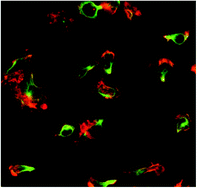Effect of adhesion and chemokine presentation on T-lymphocyte haptokinesis†
Abstract
Motility is critical for the function of T-lymphocytes. Motility in T-lymphocytes is driven by the occupancy of chemokine receptors by chemokines, and modulated by adhesive interactions. However, it is not well understood how the combination of adhesion and chemokine binding affects T-lymphocyte migration. We used microcontact printing on polymeric substrates to measure how lymphocyte migration is quantitatively controlled by adhesion and chemokine ligation. Focusing only on random motion, we found that T-lymphocytes exhibit biphasic motility in response to the substrate concentration of either ICAM-1 or VCAM-1, and generally display more active motion on ICAM-1 surfaces. Furthermore, we examined how the combination of the homeostatic chemokines CCL19 and CCL21 contribute to motility. By themselves, CCL19 and CCL21, ligands for CCR7, elicit biphasic motility, but their combination synergistically increases CCR7 mediated chemokinesis on ICAM-1. By presenting CCL21 with ICAM-1 on the surface with soluble CCL19, we observed random motion that is greater than what is observed with soluble chemokines alone. These data suggest that ICAM-1 has a greater contribution to motility than VCAM-1 and that both adhesive interactions and chemokine ligation work in concert to control T-lymphocyte motility.


 Please wait while we load your content...
Please wait while we load your content...